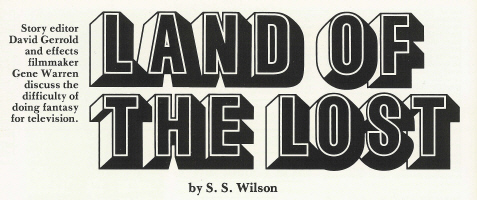
| Cinefantastique, Volume 6, Number 1 (c)1977, pg. 38 - Land of the Lost by S.S. Wilson |

from "Cinefantastique", Volume 6, Number 1 (c)1977
LAND OF THE LOST is a Sid and Marty Krofft production which survived for three seasons on NBC's Saturday morning lineup (it has not been picked up for Fall '77). The half-hour series tells the story of the Marshall family, whose "routine expedition," as the title song has it, in the Grand Canyon is interrupted by an earthquake which diverts their rubber raft over a waterfall. But instead of hitting bottom, they wake up in the LAND OF THE LOST.
The show's first season (1974-75) launched it straight into Nielsen's number one slot for Saturday morning, not because it was particularly good, but more likely because it was very *different*. Almost every episode included a considerable amount of dimensional animation in the form of model dinosaurs. To my knowledge, no TV program had ever before attempted to combine dimensional animation with live action on a regular basis, and the technique used to create the effects was quite different from conventional practice in feature film production.
The Land was different in another respect as well. As the first season unfolded, it emerged as an intriguing mixture of scrambled time and space. Not just another hideout for preserved dinosaurs, it was peopled with Pakuni (ape-like humanoids), Sleestak (reptillian descendants of a destroyed civilization), and varioud denizens of different times, dimensions, and worlds; most of whom were trapped just as the Marshalls were. Some of us older kids became interested, wondering if the series was leading up to something, an eventual grandiose explanation for the complex workings of the Land.
It wasn't.
Woe to kids and animation buffs, the second and third seasons saw the dinosaurs' appearances become less frequent and the Land became less consistent and more confusing. The show also lost its number one rating.
Before I lose all credibility over my initial praise of this show, I should establish the parameters of my criticism. We are dealing with a Saturday morning TV show which rises above its fellows *only* in its special effects and in some of its original concepts.
The live action is directed with the same utter listlessness which has infected all new Saturday morning live action shows. Network emphasis on nonviolence seems to be interpreted as meaning that characters simply do not *react* to the same old violent situations. The results are monumentally absurd.
The show's main characters suffer some very tiresome stereotyping. Will (Wesley Eure) has much in common with another Will who was LOST IN SPACE: he often disobeys his father and consistently jeopardizes the lives of everyone around him by poking into things he oughtn't. Generally Holly (Kathy Coleman) is much more level headed and often gets out of jams without help, but she is still stuck with lines like, "Yech! Worms!" Incidentally, some fans felt that Holly might be the focal point of the mystery, the key to the Marshalls' entrapment. Story personnel deny that they ever thought of her in this light. One even suggested she got more to do because Kathy Coleman, with fewer other acting commitments, was easier to schedule than the other players. Such are the realities of the business. The only special attention Holly drew in the third season was the concern that Kathy had grown too much to continue playing the part. Rather than explore the problems a lone young girl might face maturing in a lost land, the Krofft people put Kathy in low-healed shoes and show various comparative, ultimately deciding that, although much taller, she looked enough like the old Holly to pass.
Uncle Jack's arrival in the third season was made necessary when Spencer Milligan opted to leave the series. Though Jack remains strangely calm no matter what happens, Ron Harper manages to imbue him with a saving tongue-in-cheek levity.
As is often the case, the best characters are the villians and semi-villians. Particularly satisfying is Enik (expertly played by Walker Edmiston), an Altrusian, or intelligent Sleestak, trapped in his own future. Sometimes sinister, sometimes helpful, acting only for his own good, he is always an unknown factor.
All other elements aside, the most redeeming aspect of the first season's scripts was the variety. They were not simply the old kidnapping, robbery, chase and guest-star-of-the-week motifs set in a strange place. The mystery of the Land itself was the main theme. The Marshalls had to observe, experiment, and learn in order to survive in a place where even physical laws did not always apply.
The departure from this unraveling mystery doctrine, particularly in the third season, was quite marked. The feeling at Krofft was that the Land was well enough established and that *anything* could happen there, so the new stories were structured accordingly. In fact, the first episode of the third season, "After Shock," depicts the conceptual change quite literally with an earthquake which, with remarkable efficiency, divests the children of their father, drops in Uncle Jack, eliminates all the Pakuni but Cha-ka (ape-boy played by Philip Paley), and destroys the Marshalls' large (read "expensive to maintain") cave dwelling. The dust has hardly settled when Will states the new philosophy: "You never know what can happen in the Land of the Lost." Two episodes later, Uncle Jack rams the point home, noting the logical explanations are not always forthcoming in the Land.